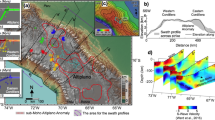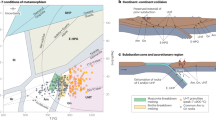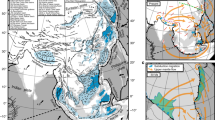Abstract
The Transantarctic Mountains are one of the world's major mountain chains, extending 3,500 km across Antarctica in a belt 200–500 km wide (Fig. 1). The region has been uplifted by at least 4 km since late Mesozoic time, yet there is none of the thrusting, folding, regional metamorphism and andesitic volcanism associated with many other large Cenozoic mountain ranges and apparently related to subduction and subsequent continental collision. Instead, the uplift of the Transantarctic Mountains is attributed here to the delayed effects of the overriding by east Antarctica of anomalously hot asthenosphere forming under west Antarctica in the late Cretaceous. Temperature increases of 100 °C are estimated at the base of the lithosphere, with mantle heat flux increasing by ∼3.5 m W m−2. These changes cause an inferred uplift rate of 90 m Myr−1some 50 Myr later. The late Cenozoic volcanism in the Transantarctic Mountains, typified by activity in Victoria Land, is attributed to the previously heated continental lithosph¨re overriding hot asthenosphere that was brought under Antarctica when it separated from Australia.
This is a preview of subscription content, access via your institution
Access options
Subscribe to this journal
Receive 51 print issues and online access
$199.00 per year
only $3.90 per issue
Buy this article
- Purchase on Springer Link
- Instant access to full article PDF
Prices may be subject to local taxes which are calculated during checkout
Similar content being viewed by others
References
Smith, A. G. Nature 296, 400–404 (1982).
Morgan, J. W. Tectonophysics 94, 126–139 (1983).
Hager, B. H. & O'Connell, R. J. Tectonophysics 50, 111–133 (1978).
Hager, B. H. & Oapos;Connell, R. J. J. geophys. Res. 84, 1031–1048 (1979).
Hager, B. H. & O'Connell, R. J. J. geophys. Res. 86, 4843–4867 (1981).
Solomon, S. C., Sleep, N. H. & Richardson, R. M. Geophys. J. R. astr. Soc. 42, 769–801 (1975).
Dalziel, I. W. D. & Elliot, D. H. Tectonics 1, 3–20 (1982).
Jankowski, E. J. thesis, Univ. Cambridge (1981).
Jankowski, E. J. & Drewry, D. J. Nature 291, 17–21 (1981).
Jankowski, E. J. ; Drewry, D. J. & Behrendt, J. C. in Antarctic Earth Science (eds Oliver, R. & Jago, J.) (Australian Academy of Science, 1983).
Davey, F. J. J. R. Soc. N.Z. 11, 465–79 (1981).
Drewry, D. J. in Antarctica: Glaciological and Geophysical Folio (ed. Drewry, D. J.) (Scott Polar Research Institute, Cambridge, 1983).
Bentley, C. R. & Clough, J. W. in Antarctic Geology and Geophysics (ed. Adie, R. J.) 683–691 (Universitetsforlaget, Oslo, 1972).
Elliot, D. A. Proc. Symp. Andean and Antarctic Volcanology Problems, Santiago, 354–372 (International Association for Volcanology and Chemistry of the Earth's Interior, 1974).
Weissel, G. P., Hayes, D. E. & Herron, E. M. Mar. Geol. 25, 231–277 (1977).
Schlater, J. G. & Parsons, B. J. geophys. Res. 86, 11535–11552 (1981).
Gleadow, A. J. W., McKelvey, B. C. & Ferguson, K. U. in Init. Rep. McMurdo Sedimentation and Tectonic Studies Project (New Zealand Geological Survey, 1982).
Gleadow, A. J. W. Paper at 4th int.Symp. Antarctic Earth Sciences, Adelaide (1982).
Decker, E. R. & Bucher, G. J. in Antarctic Geoscience (ed. Craddock, C.) 887–894 (University of Wisconsin Press, Madison 1982).
Drewry, D. J. in Antarctic Geoscience (ed. Craddock, C.) 977–984 (University of Wisconsin Press, Madison, 1982).
Armstrong, R. L. N.Z. J. Geol. Geophys. 21, 685–698 (1978).
Richardson, S. W. & England, P. C. Earth planet. Sci. Lett. 42, 183–190 (1979).
Schlater, J. G., Jaupart, C. & Galson, D. Rev. Geophys. Space Phys. 18, 269–311 (1980).
Webb, P. N. Ant. J. U.S. 6, 227–234 (1972).
Webb, P. N. & Wrenn, J. H. in Antarctic Geoscience (ed. Craddock, C.) 1117–1122 (University of Wisconsin Press, Madison, 1982).
Grindley, G. W. N.Z. J. Geol. Geophys. 10, 557–598 (1967).
Stump, E., Sheridan, M. F., Borg, S. G. & Sutter, J. F. Science 207, 757–59 (1980).
Katz, H. R. in Antarctic Geoscience (ed. Craddock, C.) 827–834 (University of Wisconsin Press, Madison, 1982).
Drewry, D. J. J. geol. Soc. Lond. 131, 255–273 (1975).
McGregor, V. R. & Wade, F. A. in Geologie Maps of Antarctica (eds Bushnell, V. C. & Craddock, C.) Sheet 16 (American Geographical Society, New York, 1969).
Author information
Authors and Affiliations
Rights and permissions
About this article
Cite this article
Smith, A., Drewry, D. Delayed phase change due to hot asthenosphere causes Transantarctic uplift?. Nature 309, 536–538 (1984). https://doi.org/10.1038/309536a0
Received:
Accepted:
Issue Date:
DOI: https://doi.org/10.1038/309536a0
This article is cited by
-
Decompensative Gravity Anomalies Reveal the Structure of the Upper Crust of Antarctica
Pure and Applied Geophysics (2019)
-
Lithospheric structure below transantarctic mountain using receiver function analysis of TAMSEIS data
Journal of the Geological Society of India (2014)
-
Revised history of early Tertiary plate motion in the south-west Pacific
Nature (1987)
Comments
By submitting a comment you agree to abide by our Terms and Community Guidelines. If you find something abusive or that does not comply with our terms or guidelines please flag it as inappropriate.



